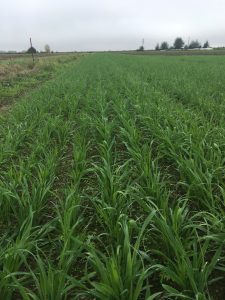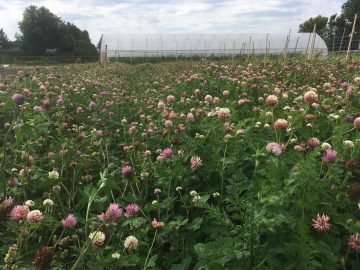Project lead: Raelani Kesler
Project personnel: Arisa Nakada, Emma Yates, Carson Li
Supervisor: Dr. Sean Smukler
Project funding: Ministry of Agriculture and Food
The adoption of cover crops by growers helps support healthy agricultural environments and promote ecosystem services provided by farmland. Many cover crop species have been identified for their ability to scavenge nutrients, suppress weeds, reduce erosion, build soil organic matter, and as an integrated pest management strategy. Selection depends on a variety of factors, including suitability to local weather and soil conditions and alignment with producers’ goals. A variety of information exists about the characteristics of different cover crops and their performance in different regions of British Columbia (B.C.). Much of the data and literature from research on cover crops in B.C. and elsewhere is available in scientific publications behind a paywall and has been geared towards academic audiences, making it largely inaccessible to growers. In some regions of North America, there has been substantial efforts to synthesize cover crop scientific literature so that it is more accessible to growers in publications such as books, reports, briefs and online through websites and selection tools. In B.C. however, regionally specific cover crop literature remains largely inaccessible. The overarching objective of this project was to lay the groundwork for the development of tools to assist B.C. growers with cover crop selection and management strategies.
Project objectives
- Review the scientific literature on cover crops and consult with local cover crop experts to consolidate this information into a preliminary B.C.-specific database.
- Review existing cover crop selection tools and engage with their developers to understand potential opportunities for collaboration.
- Provide a set of recommendations for the development of an online cover crop tool and identify specific research gaps.
The preliminary database developed for this project draws on information from published peer-reviewed articles, books, scientific experts, and extension materials. The purpose of this database is to supply the underlying information for an online cover crop selection tool for use by B.C. growers. Currently, the database consists of 23 cover crop species for which there was sufficient information from B.C. to contextualize general information presented in other selection tools and literature outside the province.
A literature review was conducted for all published and peer-reviewed work on cover crops in B.C. using the Web of Science database. Literature was also sourced from researchers and provincial experts with knowledge of work conducted
on cover crops over the past three decades. Extension publications from the Pacific Northwest of the United States (Washington, Oregon, and Idaho) were also evaluated, including published work from Washington State University, Oregon State University, and NRCS Plant Material Information Centers. B.C. cover crop experts, including producers, researchers, and seed company representatives, were consulted in the development of the preliminary database. To provide recommendation on the development of an online cover crop selection tool, developers of similar tools in the US and Eastern Canada were consulted.
The database is organized by seven themes and corresponding metrics:
Basic information: Common name, scientific name, cover crop type, short description
Planting: Seeding depth, rate, mode, and comments
Termination: Mode, ease, and comments
Goals/selection criteria: Nitrogen fixation, nitrogen scavenger, organic matter/soil builder, reduces compaction, reduces erosion, suppresses weeds, winter survival, quick growth, residue breakdown, biofumigation, forage harvest value, grain/seed harvest value, interseed with cash crop, volunteer establishment
Environmental tolerances: Flood, drought, shade, heat, low fertility, salinity, drainage, pH, and comments
Growth traits: Rooting depth, growth habit, life cycle, inoculation type, minimum germination temperature, dry matter yield, nitrogen concentration, nitrogen contribution
Ecoprovince comments: Results from studies conducted within specific ecoregions are displayed
Cover crop goals and environmental tolerances are ranked on a relative scale from 1-5. The scale is interpreted as 1-poor, 2-fair, 3-good, 4-very good, 5-excellent. All other information is numerical (e.g., dry matter yield, N contribution), text based (e.g., scientific names, definitions), or categorical (e.g., cover crop type). Rankings in the preliminary database were taken from the PNW database and adjusted given information from B.C. literature and augmented with information from other databases when regional data was unavailable. Sources are referenced in APA formatting corresponding to the source materials document. Winter hardiness tolerances were determined using temperatures associated with British Columbia Plant Hardiness Zones.
Results and recommendations
The report is currently under review and will be linked here when released.

